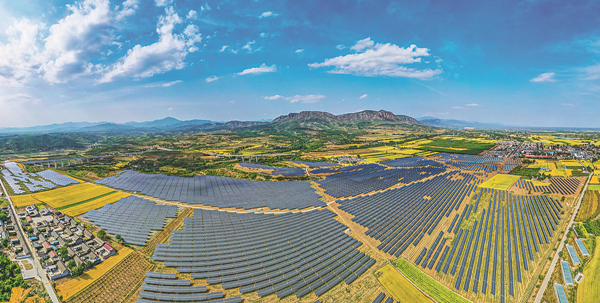Making a clean break
Updated: 2022-06-22

Final assembly is done in Yuncheng in January at a new energy vehicle plant of Shanxi-based Dayun Automobiles. [Photo/China Daily]
Coal-rich province rolls out wide-ranging measures on energy transformation to help meet country's low-carbon goals
For villager Wang Fugui, who lives in Tianzhen county of North China's Shanxi province, the shift from coal to clean energy for heating has improved the quality and comfort of his life.
"In previous years, I had to get up in the dark and add coal to the stove several times a day. The house was always dirty and full of dust; it was very exhausting," Wang said.
"After the local government helped us install electric heating, it has saved us a lot of trouble and money. It's now clean and safe, and as warm as springtime, even in the first few days of winter."
Wang is among the beneficiaries throughout Shanxi of a wide-ranging transition to clean energy generation and consumption. The coal-rich province has traditionally relied heavily on the fossil fuel to feed furnaces across China in order to help power the nation's rapid development in recent decades.
China aims to peak carbon dioxide emissions before 2030 and achieve carbon neutrality before 2060.According to an action plan released last year, the country is set to raise the share of nonfossil energy consumption to about 25 percent by 2030, and lower CO2 emissions per unit of GDP by more than 65 percent by 2030, compared with the 2005 level.
During this year's two sessions-the annual meetings of China's top legislative and political advisory bodies-President Xi Jinping said that achieving the carbon peak and carbon neutrality goals is "a broad and profound initiative and a long-term task, which should be advanced with unswerving efforts and in a scientific and orderly manner".
Shanxi is moving to the forefront of the green push as it gears up the reform of its pillar energy sector, including the extensive implementation of energy-saving measures and promotion of carbon-reducing technologies.
Major steps, such as the cleanup of polluting enterprises along the Yellow River and the rollout of ultra-low emissions standards for industry, are set to help the province achieve an annual reduction of more than 3 percent in energy consumption per unit of GDP, according to provincial authorities.
The moves have reached major coal-related stakeholders across the province, covering at least 22 iron and steel joint enterprises, 14 coking enterprises and 10 cement enterprises, which completed ultra-low emission transformation of bulk coal last year.

Hundreds of electric taxis are ready for use in Yuncheng, Shanxi province, in April 2020. [Photo by Xue Jun for China Daily]
Expanding green GDP
This year will see the consolidation and enhancement of carbon sink capabilities-carbon sinks are such things as forests and oceans that absorb more carbon than they release-as well as near-zero carbon emission initiatives, carbon peak pilot demonstration projects, and research in carbon capture, utilization and storage technologies, according to the provincial work plan.
Reaffirming Shanxi's green priorities, provincial Governor Lan Fo'an said Shanxi should "strengthen research on energy-saving and low-carbon technologies, promote energy conservation and carbon reduction in key areas, and continuously expand its green GDP with low energy consumption and low emissions".
Leveraging the province's energy experience, expertise and infrastructure has been integral to the green transition. An "intelligent transformation" of Shanxi's coal mines to reduce fuel consumption and adapt to the latest green technologies to upgrade the industry covers more than 1,000 major mines and related projects, according to provincial figures.
At energy giant Shanxi Ruiguang Heat and Power, based in the city of Jinzhong, a focus on scientific and technological innovation has made major headway in areas such as waste steam and heat recycling, carbon dioxide capture and utilization, and intelligent fuel control systems to help achieve ultra-low emissions and energy saving, according to the company.
One of its latest projects includes the recovery, storage and mobile use of boiler flue gas, using high-performance heat-absorbing materials to take in and store heat. The project's total waste heat capacity is equivalent to about 12,560 metric tons of standard coal, reducing CO2 emissions by about 31,310 tons, according to company figures.
Under its green approach, the company's coal consumption for power generation is at least 4.7 percent lower than the province's average energy consumption, said deputy general manager and chief engineer Dong Xin.
Major retrofitting work for heating capacity at facilities has also been optimized, with one project saving up to 2,280 tons of standard coal and reducing CO2 emissions by about 5,680 tons a year, Dong said.
"We plan to launch a coal optimization project," Dong said. "We also plan to replace coal trucks with 50 electric heavy-duty trucks, which can save fuel and reduce production costs."
In 2014, the company was the first in Shanxi to move to ultra-low emissions. Anti-pollution achievements include reducing annual emissions of soot by more than 500 tons, sulfur dioxide by about 1,300 tons, and nitrogen oxides by over 1,200 tons, Dong said.
Other recycling initiatives include a pilot project to capture carbon dioxide emissions from power plants to yield liquid CO2 with a purity of about 99 percent, for uses ranging from firefighting materials to plant fertilizer and food refrigeration, Dong said.
"Our company is actively exploring new technologies to make breakthroughs in extending the use of carbon dioxide in the industry chain," he said.
To reduce groundwater use, Shanxi Ruiguang Heat and Power recycles water from its production processes. Under a major urban sewage treatment project involving a daily processing capacity of 200,000 tons, a total of 54.33 million tons of water was processed in 2021, with 1.52 million tons channeled for direct use by the company, and the rest for greening, sanitation, ecological restoration and other uses, Dong said.
The company's "clean coal"-fired facility management projects include extending its use of computers and robots under a "smart coal plant "concept, further cutting labor and production costs, Dong said.
"Finding a suitable green transformation plan is key. It requires a lot of determination, but the switch is inevitable for enterprises," he added.
At Lu'an Chemical Group, optimizing, diversifying and upgrading the use of the province's resources and improving coal efficiency take priority.
Recognizing that the inefficient use of coal adds significantly to pollution risks, the group, based in the city of Changzhi, has rolled out a million-ton liquefaction demonstration project.
Its coal liquefaction production line contributes a total of 1.8 million tons of oil products and chemicals annually, which can be turned into more than 160 products such as oils for engines, drones and construction machinery.
The project also focuses on the treatment and processing of pollutants to realize the clean and optimal use of coal, according to the company.
Coal-derived synthetic products can sell for 30 times more than their base material after processing, Lu'an engineer Yang Zeqing said.

A large array of photovoltaic panels has boosted capacity at a solar power station in Yuanqu county, Shanxi province. [Photo/China Daily]
Energy security
Lu'an Chemical Group Chairman Wang Zhiqing said, "From the perspective of energy security, the development of the coal-to-oil industry is of great significance to our country."
In other efforts to leverage the region's resources, traditional industry leaders like Shanxi International Energy Group are launching renewable energy projects, including a 6-million-kilowatt wind and solar energy storage facility.
The group reported installed capacity of new energy sources, such as wind power and photovoltaic energy, exceeding 1 million kilowatts. It has also reported eight major grid-connected, photovoltaic power generation projects in the province, with a total installed capacity of 820,000 kW, and plans for other new energy projects totaling 1.23 million kW.
During the nation's 14th Five-Year Plan period (2021-25), the group has set out to "actively explore cooperation projects for clean energy bases at home and abroad, with an installed capacity of more than 8 million kilowatts of new energy, laying a solid foundation for building a green, efficient and low-carbon modern energy enterprise", the company said.
New and clean energy generation across Shanxi has already more than doubled in recent years, making up more than one-third of capacity in the province, industry figures show.
During the 13th Five-Year Plan period (2016-20), Shanxi's installed wind power capacity increased by an average of 24.16 percent a year. Installed photovoltaic capacity rose an average of 63.22 percent annually, with base photovoltaic capacity hitting 4 million kW to help propel the province to the forefront of the sector nationwide.
On the banks of the Yellow River, about 350 kilometers southwest of Changzhi, is Zhuangshang village, one of the first communities in the province to conduct a trial of widespread solar energy use. From household appliances to farming machinery, residents from more than 20 households tap power from a micro grid linked to photovoltaic panels on their roofs, under a power generation network developed by Guochen Group.
Villager Chen Yongmin called a device hanging under the eaves of his house the "sunshine treasure box".
"It turns the sunlight from the panels above into power for our home," Chen said. "We don't have electricity bills now and can even sell excess power to the grid."
Chen's solar power system, with four main panels offering a total capacity of 2 kW, was set up with 10,000 yuan, and he expects to recover the cost within six years, with stable income generated thereafter under a service cycle for the system stretching more than two decades.
Chen Wenbo, the Guochen chairman, said the micro grid setup for consolidating, storing and distributing solar power from villagers' homes means that they will not be affected even if there is less than ideal weather for charging up the photovoltaic panels.
Hydrogen development
Other than solar and wind power, the province is turning its attention to the development of hydrogen, including the production of hydrogen fuel cells for vehicles.
Hydrogen industry clusters have been created in major cities such as Taiyuan, Datong and Jinzhong. The annual hydrogen production capacity of the province has reached 3 million tons, according to the Shanxi Energy Administration.
The green inroads are being felt on the ground by residents like Zhao Gang, who works in the city of Linfen and drives a new energy vehicle back to Sanhe village, about an hour away, to visit his parents.
"There's a charging station in my hometown, so I don't have to worry about making the trip anymore."
The charging station is located opposite the Sanhe primary school. It is equipped with a 60 kW electric vehicle charger, which many motorists such as Zhao said reflects the new energy sources, technologies and services helping to improve people's lives. The local power and utilities supplier has invested more than 90 million yuan to build more than 100 charging stations throughout the city.
Meanwhile, Shanxi's green investments are closely felt in the improvement of its air quality.
In 2021, the average annual concentration of PM2.5-particulate matter smaller than 2.5 microns that is harmful to health-in more than 10 major districts and cities in the province fell to a record low of 39 micrograms per cubic meter, according to industry figures.
In addition, the average annual concentration of the air pollutant nitrogen dioxide met industry safety levels, and sulfur dioxide concentrations improved for four consecutive years, with the proportion of days recording good air quality hitting more than 72 percent.
Wang Yanfeng, director of the provincial department of ecology and environment, said that promoting green energy consumption and pollution reduction in Shanxi is intricately linked to ecological protection and high-quality development in the Yellow River basin area.
"Aiming for blue skies, clear waters and beautiful land will involve vigorously supporting the market-oriented development of the low-carbon industry, further improving the industrial chain, and working to build a low-carbon 'Shanxi model'," Wang said.
Peng Ke'er contributed to this story.



